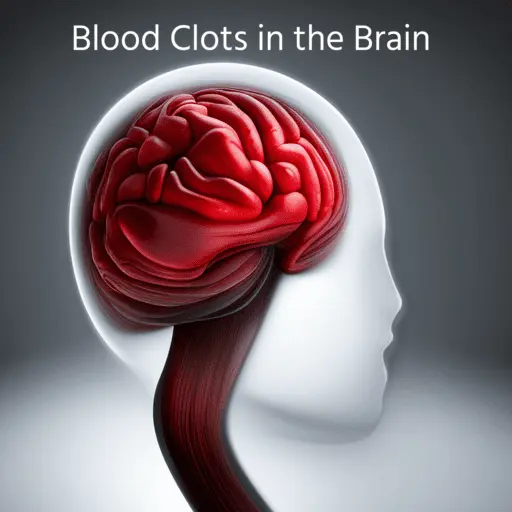Blood clots in the brain, also known as cerebral venous thrombosis (CVT), are a serious medical condition that can have severe consequences if not promptly diagnosed and treated.
These clots occur when a vein in the brain becomes blocked, preventing blood from flowing properly. The obstruction can lead to a variety of symptoms and complications, including stroke and brain damage.
It is important to understand the causes, symptoms, and treatment options for blood clots in the brain to ensure early detection and appropriate medical intervention.
Common Causes of Blood Clots in the Brain
Blood clots in the brain, also known as cerebral thrombosis or cerebral embolism, can be caused by various factors. Some common causes include:
- Atherosclerosis refers to the accumulation of plaque in the arteries, potentially causing the formation of blood clots.
- Atrial fibrillation is an irregular heartbeat that raises the possibility of clots forming in the heart and then traveling to the brain.
- High blood pressure, or hypertension, can harm blood vessels and raise the chances of clot formation.
- Smoking cigarettes can narrow blood vessels and encourage the development of clots.
Identifying Potential Risk Factors
Several risk factors may predispose individuals to blood clots in the brain. It’s important to be aware of these factors to take preventive measures. Some potential risk factors include:
- Age: The risk of blood clots increases with age.
- Family history: Individuals with a family history of blood clots are more likely to develop them.
- Obesity: Excess weight can contribute to the development of blood clots.
- Certain medical conditions: Conditions such as diabetes, high cholesterol, and autoimmune disorders can increase the risk of clot formation.
Understanding the common causes and potential risk factors can help individuals take steps to prevent blood clots in the brain and maintain their overall health.
Common Symptoms of Blood Clots in the Brain
When a blood clot forms in the brain, it can lead to various symptoms that may indicate a potential stroke or other serious medical condition. Some common symptoms of blood clots in the brain include:
- Sudden severe headache
- Weakness or numbness on one side of the body
- Difficulty speaking or understanding speech
- Loss of coordination or balance
- Changes in vision
- Dizziness or loss of consciousness
It is essential to recognize these symptoms and seek immediate medical attention if they occur, as early diagnosis and treatment can significantly improve outcomes.
Diagnostic Methods and Imaging Techniques
To diagnose blood clots in the brain, healthcare professionals utilize various diagnostic methods and imaging techniques, including:
- Magnetic Resonance Imaging (MRI): This imaging technique uses strong magnetic fields and radio waves to create detailed images of the brain, helping to detect blood clots and assess their size and location.
- Computed Tomography (CT) Scan: CT scans use X-rays to create cross-sectional images of the brain, enabling healthcare professionals to visualize and identify blood clots.
- Cerebral Angiography: This procedure involves injecting a contrast dye into the blood vessels of the brain and using X-rays to see if any blood vessels are blocked by clots.
- Transcranial Doppler (TCD): TCD utilizes ultrasound technology to evaluate the blood flow within the brain and identify any abnormalities, including the presence of blood clots.
These diagnostic methods and imaging techniques play a crucial role in determining the presence of blood clots in the brain and guiding the appropriate treatment plan. Early detection and intervention are vital in preventing serious complications associated with blood clots in the brain.
Treatment Options
Medical Interventions for Blood Clots in the Brain
- Anticoagulant Medications: Anticoagulant medications, such as heparin or warfarin, are commonly used to prevent the formation of blood clots or to help dissolve existing clots in the brain. These medications work by thinning the blood and preventing platelets from sticking together.
- Thrombolytic Therapy: Thrombolytic therapy, also known as clot-busting therapy, involves the administration of medication that helps dissolve blood clots in the brain. This treatment is time-sensitive and is often used in the case of an ischemic stroke.
- Antiplatelet Medications: Antiplatelet medications, such as aspirin, clopidogrel, or ticagrelor, are commonly prescribed to prevent the formation of blood clots. These medications work by inhibiting platelet aggregation, reducing the risk of clot formation in the brain.
Surgical Procedures and Therapies
- Clipping: In some cases of a cerebral aneurysm, a surgical procedure called clipping may be performed. During this procedure, a small metal clip is placed around the neck of the aneurysm to stop the flow of blood and prevent rupture.
- Coiling: Coiling is an alternative to clipping and involves the insertion of a small flexible tube, called a catheter, into the blood vessel. Platinum coils are then placed in the aneurysm to promote blood clotting and prevent rupture.
- Surgical Removal: In cases where a blood clot in the brain is causing severe symptoms or there is a high risk of rupture, surgical removal of the clot may be necessary. This procedure, known as an embolectomy, involves the removal of the clot using specialized surgical tools.
Preventive Measures to Reduce the Risk of Blood Clots
Preventing blood clots in the brain is essential for maintaining good overall health. Here are some preventive measures that can help reduce the risk of blood clots:
- Maintain a Healthy Weight: Being overweight or obese increases the risk of developing blood clots. Maintaining a healthy weight through regular exercise and a balanced diet can lower the risk.
- Stay Active: Regular physical activity helps improve blood circulation and reduces the chances of blood clot formation. Engaging in activities such as walking, jogging, or swimming can be beneficial.
- Avoid Prolonged Immobility: Sitting or standing in the same position for extended periods can increase the risk of blood clots. Taking breaks and moving around regularly can help prevent clotting.
- Stay Hydrated: Drinking an adequate amount of water keeps the blood flowing smoothly and prevents it from becoming too thick, reducing the risk of clot formation.
Adopting a Healthy Lifestyle
In addition to preventive measures, adopting a healthy lifestyle can further reduce the risk of blood clots. Here are some lifestyle changes that can help:
- Quit Smoking: Smoking damages blood vessels and increases the risk of clot formation. Quitting smoking is essential for reducing the risk of blood clots in the brain and other parts of the body.
- Eat a Balanced Diet: Consuming a diet rich in fruits, vegetables, whole grains, and lean proteins can provide the necessary nutrients for optimal cardiovascular health and reduce the risk of blood clots.
- Manage Chronic Conditions: Conditions such as diabetes, high blood pressure, and high cholesterol increase the risk of blood clot formation. Proper management of these conditions through medication, lifestyle changes, and regular consultations with healthcare professionals is crucial.
- Stop Alcohol Consumption: Alcohol consumption can contribute to blood clot formation. Stopping alcohol intake is mandatory.
By implementing these preventive measures and adopting a healthy lifestyle, individuals can significantly reduce the risk of blood clots, including those in the brain. It is always advisable to consult with a healthcare professional for personalized guidance and recommendations.
Prognosis and Complications
After a blood clot forms in the brain, the prognosis and outcomes can vary depending on the size, location, and treatment of the clot. Prompt medical intervention is crucial in improving the prognosis for patients with blood clots in the brain. With timely treatment, many individuals can experience a good recovery and regain their normal brain function. However, it is important to note that every case is unique, and the outcome can be influenced by various factors.
Blood clots in the brain can potentially lead to various complications and long-term effects, including:
- Stroke: A blood clot in the brain can cause a stroke, which can result in permanent brain damage and disabilities.
- Cognitive Impairment: Depending on the severity and location of the clot, cognitive impairments such as memory loss, difficulty concentrating, and problems with speech and language may occur.
- Seizures: In some cases, blood clots in the brain can trigger seizures, which are sudden and uncontrolled electrical disturbances in the brain.
It is important for individuals who have experienced blood clots in the brain to receive ongoing medical care and monitoring to manage any potential complications and ensure the best possible long-term outcomes.
About the Author
Reyus Mammadli is the author of this health blog since 2008. With a background in medical and biotechnical devices, he has over 15 years of experience working with medical literature and expert guidelines from WHO, CDC, Mayo Clinic, and others. His goal is to present clear, accurate health information for everyday readers — not as a substitute for medical advice.







